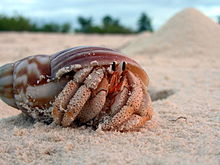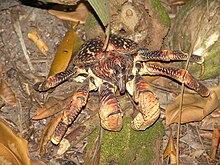
Hermit crabs are anomuran decapod crustaceans of the superfamily Paguroidea that have adapted to occupy empty scavenged mollusc shells to protect their fragile exoskeletons. There are over 800 species of hermit crab, most of which possess an asymmetric abdomen concealed by a snug-fitting shell. Hermit crabs' soft (non-calcified) abdominal exoskeleton means they must occupy shelter produced by other organisms or risk being defenseless.

The genus Coenobita contains 17 species of terrestrial hermit crabs. Several species in this genus are kept as pets.

The Diogenidae are a family of hermit crabs, sometimes known as "left-handed hermit crabs" because in contrast to most other hermit crabs, its left chela (claw) is enlarged instead of the right. It comprises 429 extant species, and a further 46 extinct species, making it the second-largest family of marine hermit crabs, after the Paguridae.

Coenobita cavipes is a species of land hermit crab native to the eastern parts of Africa, the Indonesia, Philippines, China, Japan, Malaysia, Taiwan, Polynesia, and Micronesia. While these hermit crabs are terrestrial, they prefer to reside near the shores for access of both water and land.

Coenobita brevimanus is a species of terrestrial hermit crab belonging to the family Coenobitidae, which is composed of coastal living terrestrial hermit crabs. From there it belongs to the genus Coenobita, one of two genera split from the family, which contains sixteen species. The Latin origins of the species name, brevimanus, come from the adjective brevis ("small") and the noun manus ("hands"). It is known as the Indos crab or Indonesian crab because it is primarily distributed throughout the Indo-Pacific.

The Paguridae are a family of hermit crabs of the order Decapoda. The king crabs, Lithodidae, are now widely understood to be derived from deep within the Paguridae, with some authors placing their ancestors within the genus Pagurus.

Calcinus is a genus of hermit crabs in the family Diogenidae, containing the following species:

The Parapaguridae are a family of marine hermit crabs from deep waters. Instead of carrying empty gastropod shells like other hermit crabs, they carry colonies of dozen or more sea anemones or zoanthids. Some genera, such as Bivalvopagurus and Tylaspis, do not inhabit shells. The following genera are included:

The Pylochelidae are a family of hermit crabs. Its members are commonly called the 'symmetrical hermit crabs'. They live in all the world's oceans, except the Arctic and the Antarctic, at depths of 2,000 m (6,600 ft). Due to their cryptic nature and relative scarcity, only around 60 specimens had been collected before 1987, when a monograph was published detailing a further 400.

Dardanus gemmatus, the jeweled anemone hermit crab, is a species of hermit crab native to tropical reefs surrounding the Indo-Pacific, typically at depths of 2–100 metres (10–330 ft).
Ciliopagurus liui is a species of hermit crab native to the Gulf of Tonkin and waters to the south of Japan.

Dardanus venosus, the starry-eyed crab or stareye crab, is a species of hermit crab in the family Diogenidae. It occurs in shallow water on the eastern coasts of America from Florida southward to Brazil. It is sometimes kept in reef aquaria.

The thinstripe hermit crab, Clibanarius vittatus, is a species of hermit crab in the family Diogenidae. It is found in the Caribbean Sea, the Gulf of Mexico and the western Atlantic Ocean.

Coenobita scaevola is a species of terrestrial hermit crab from the western Indian Ocean and Red Sea.

Dardanus lagopodes, known commonly as the hairy red hermit crab, is a species of marine decapod crustacean in the family Diogenidae. Dardanus lagopodes is widespread throughout the tropical waters of the Indo-West Pacific region, including the Red Sea. It reaches a length of 10 centimetres (3.9 in).

Aniculus maximus, the hairy yellow hermit crab or large hairy hermit crab, is an aquatic hermit crab of the family Diogenidae.

Dardanus tinctor, the anemone hermit crab, is a species of marine hermit crab in the family Diogenidae. Dardanus tinctor is widespread throughout the tropical waters of the Indo-West Pacific region, including the Red Sea. It reaches a length of 10 centimetres (3.9 in).

Coenobita rubescens is a species of terrestrial (land-living) hermit crab, family Coenobitidae.
Tylaspis is a genus of hermit crabs in the family Parapaguridae. Its only known species is Tylaspis anomala.
Coenobita pseudorugosus is a species of terrestrial hermit crab, family Coenobitidae.




















